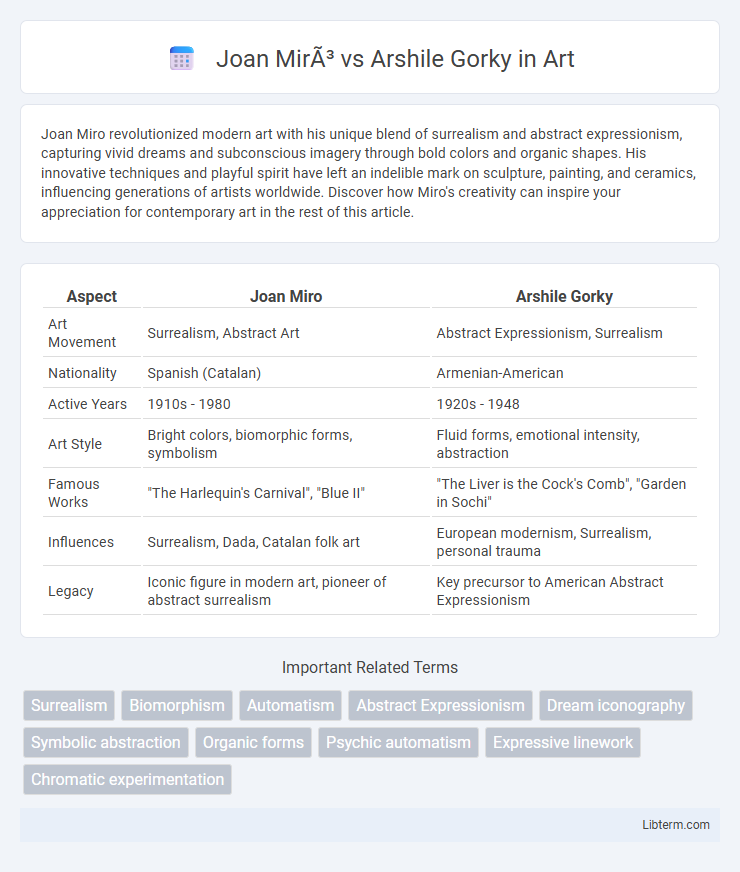Joan Miro revolutionized modern art with his unique blend of surrealism and abstract expressionism, capturing vivid dreams and subconscious imagery through bold colors and organic shapes. His innovative techniques and playful spirit have left an indelible mark on sculpture, painting, and ceramics, influencing generations of artists worldwide. Discover how Miro's creativity can inspire your appreciation for contemporary art in the rest of this article.
Table of Comparison
| Aspect | Joan Miro | Arshile Gorky |
|---|---|---|
| Art Movement | Surrealism, Abstract Art | Abstract Expressionism, Surrealism |
| Nationality | Spanish (Catalan) | Armenian-American |
| Active Years | 1910s - 1980 | 1920s - 1948 |
| Art Style | Bright colors, biomorphic forms, symbolism | Fluid forms, emotional intensity, abstraction |
| Famous Works | "The Harlequin's Carnival", "Blue II" | "The Liver is the Cock's Comb", "Garden in Sochi" |
| Influences | Surrealism, Dada, Catalan folk art | European modernism, Surrealism, personal trauma |
| Legacy | Iconic figure in modern art, pioneer of abstract surrealism | Key precursor to American Abstract Expressionism |
Introduction to Joan Miró and Arshile Gorky
Joan Miro, a Catalan painter and sculptor born in 1893, is renowned for his contributions to Surrealism and his use of bold colors and abstract forms that evoke dreamlike imagery. Arshile Gorky, an Armenian-American artist born in 1904, played a pivotal role in Abstract Expressionism with his biomorphic shapes and emotionally charged compositions influenced by his traumatic past. Both artists significantly shaped 20th-century modern art through distinct yet innovative approaches to abstraction and symbolism.
Artistic Backgrounds and Influences
Joan Miro's artistic background was deeply rooted in Catalan culture, Surrealism, and Fauvism, with influences from Vincent van Gogh and Pablo Picasso that shaped his vibrant, abstract style. Arshile Gorky, shaped by his Armenian heritage and the trauma of the Armenian Genocide, blended European modernism with Abstract Expressionism, drawing inspiration from artists like Giorgio de Chirico and Paul Cezanne. Both artists synthesized personal and cultural experiences, yet Miro's work emphasized symbolism and dream-like imagery while Gorky's focused on emotional depth and biomorphic forms.
Core Styles and Techniques Compared
Joan Miro's core style is characterized by surrealist abstraction, featuring vivid colors, organic shapes, and playful, biomorphic forms that evoke dreamlike, spontaneous imagery. In contrast, Arshile Gorky's work blends abstract expressionism with surrealism, using gestural brushwork, layered textures, and a more introspective palette to convey emotional depth and complex symbolism. Miro emphasizes simplicity and spontaneity through flat, graphic surfaces, while Gorky's technique involves dynamic compositions with fluid lines and a strong sense of movement and psychological intensity.
Use of Color and Form
Joan Miro's use of color is characterized by bold primary hues and playful shapes, creating abstract compositions that evoke whimsy and spontaneity. Arshile Gorky employed a softer, more muted palette with fluid, biomorphic forms that blend surrealism and abstraction, producing emotionally charged and layered visual narratives. Both artists manipulate form and color distinctively to explore subconscious imagery, yet Miro emphasizes a childlike clarity while Gorky presents a more complex, poetic abstraction.
Surrealism: Miró’s Playful Abstraction vs Gorky’s Emotional Depth
Joan Miro's Surrealism is characterized by playful abstraction, using vibrant colors, whimsical shapes, and symbolic motifs that evoke a dreamlike spontaneity. In contrast, Arshile Gorky's Surrealism delves into emotional depth through biomorphic forms and layered textures that express personal trauma and subconscious complexity. Both artists contribute uniquely to Surrealism, with Miro emphasizing imaginative freedom and Gorky exploring psychological intensity.
Key Works and Signature Motifs
Joan Miro's key works include "The Harlequin's Carnival" and "Blue II," showcasing his vibrant use of biomorphic shapes, bold primary colors, and playful symbolism emphasizing surrealism and automatism. Arshile Gorky's signature pieces such as "The Liver Is the Cock's Comb" and "Garden in Sochi" highlight his fusion of abstract expressionism and biomorphism, featuring organic forms and layered textures inspired by memory and trauma. Both artists employ abstract shapes and fluid lines, yet Miro's motifs lean toward whimsical, childlike imagery while Gorky's evoke emotional depth and existential complexity.
Impact on Modern Art Movements
Joan Miro's impact on Surrealism and Abstract Expressionism is marked by his use of bold colors and biomorphic forms that inspired later avant-garde artists. Arshile Gorky's contribution to Abstract Expressionism bridged European modernism and American art, influencing key figures like Jackson Pollock with his fluid shapes and emotive brushwork. Both artists played pivotal roles in shaping 20th-century Modern Art movements through their innovative approaches to abstraction and emotional expression.
Personal Struggles and Their Artistic Reflections
Joan Miro's personal struggles with political turmoil in Spain deeply influenced his surrealist style, characterized by bold symbols and vibrant colors reflecting hope and freedom. Arshile Gorky's traumatic experiences as an Armenian genocide survivor profoundly shaped his abstract expressionism, embedding themes of loss, memory, and identity in his work. Both artists transformed personal anguish into innovative visual languages that continue to resonate in modern art.
Legacy and Global Recognition
Joan Miro's legacy is marked by his pioneering role in Surrealism and abstract art, with global recognition evident through exhibitions in major museums such as the Museum of Modern Art in New York and the Reina Sofia in Madrid. Arshile Gorky's influence on Abstract Expressionism secured his place in art history, with his works housed in institutions like the Tate Modern in London and the Smithsonian American Art Museum. Both artists have significantly shaped modern art, yet Miro's broader international acclaim underscores his enduring impact on contemporary visual culture.
Miró vs Gorky: Lasting Influence on Contemporary Art
Joan Miro's lasting influence on contemporary art stems from his pioneering use of abstract surrealism, vivid color palettes, and symbolic forms that continue to inspire modern artists exploring subconscious imagery. Arshile Gorky's impact lies in bridging European surrealism and American abstract expressionism, with his biomorphic shapes and emotional intensity shaping the development of postwar art movements. Both artists remain central to contemporary discussions on abstraction and emotional expression, with Miro's playful symbolism and Gorky's synthesis of styles enriching global art narratives.
Joan Miró Infographic

 libterm.com
libterm.com